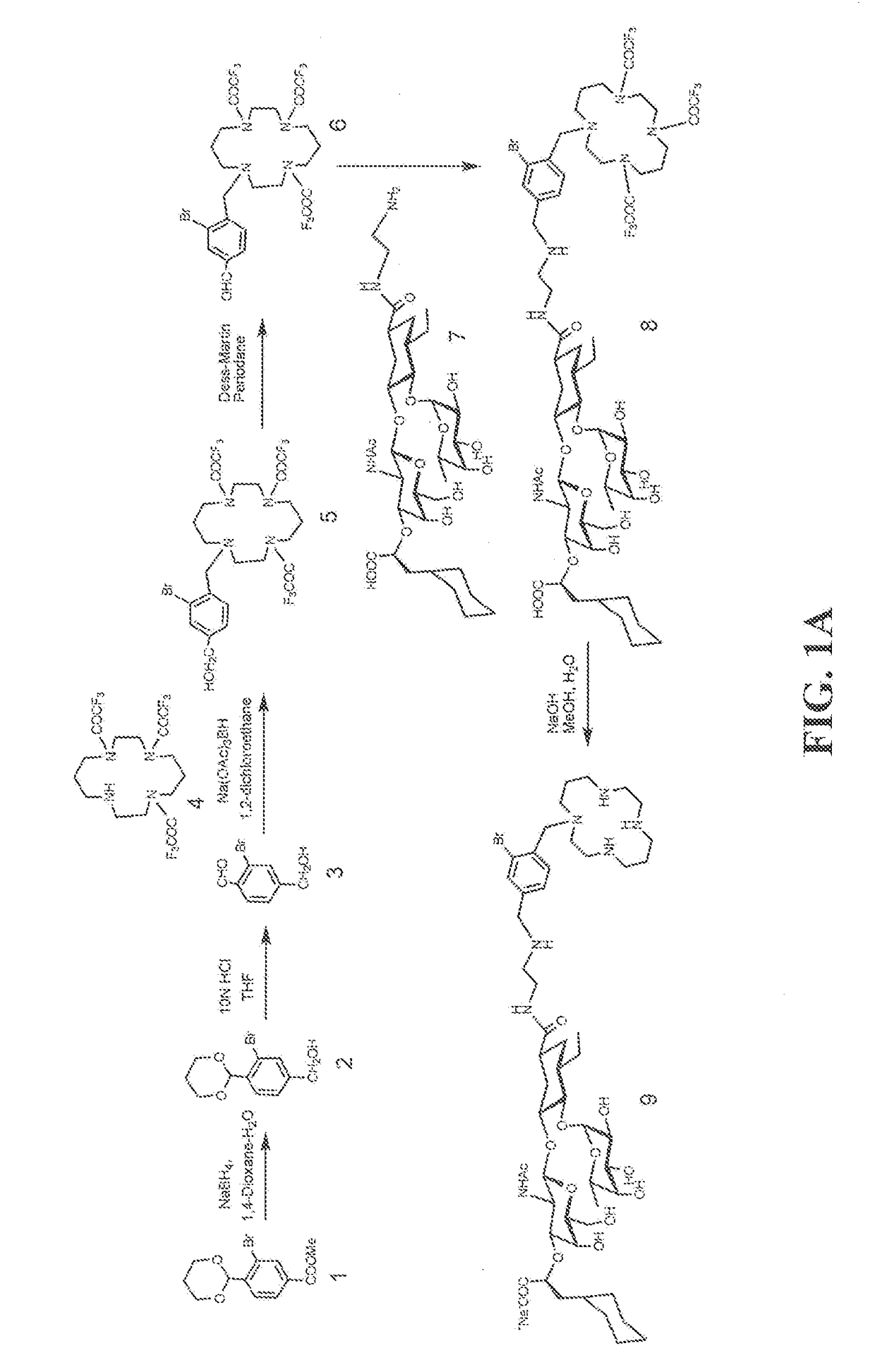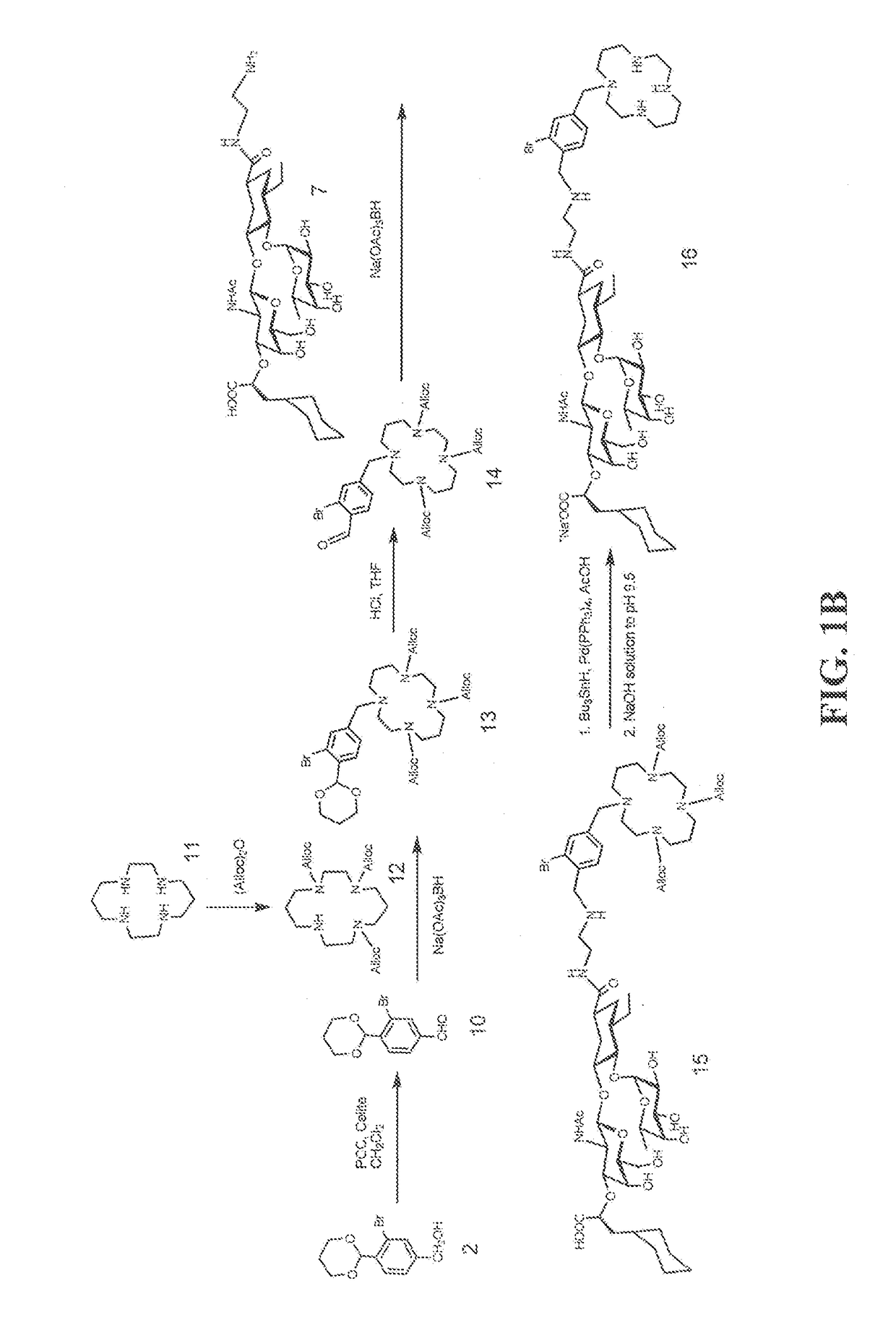Heterobifunctional inhibitors of e-selectins and cxcr4 chemokine receptors
a technology of eselectins and chemokine receptors, which is applied in the field of heterofunctional inhibitors of eselectins and cxcr4 chemokine receptors, can solve the problems of reducing survival statistics, increasing the risk of treatment, and pain in individuals, and achieves the effect of enhancing cell retention
- Summary
- Abstract
- Description
- Claims
- Application Information
AI Technical Summary
Benefits of technology
Problems solved by technology
Method used
Image
Examples
example 1
[0131]Heterobifunctional Inhibitor of E-Selectin AND CXCR4 Chemokine Receptor (Compounds 9 and 16)
[0132]Exemplary heterobifunctional compounds of Formula (I) were synthesized as described in Examples 1-2 and as shown in the exemplary synthesis schemes set forth in FIG. 1.
[0133]Synthesis of compound 2: Compound 1 (2.5 g, 8.3 mmol, Qian et al, Nature Communications, 2, 2011, 495) was dissolved in dioxane (30 ml) and H2O (20 ml) was added slowly with stirring at room temperature. The solution was cooled to 0° C. (ice bath) and NaBH4 (3 g, 79.3 mmol) was added slowly with stirring. The reaction mixture was stirred at 64° C. for 16 h. The reaction mixture was cooled to 0° C. and quenched with 5N HCl. A solid mass precipitated out of solution which was removed by filtration. The filtrate was diluted with EtOAc (125 ml) and transferred to a separatory funnel. The phases were separated. The organic phase was washed with saline (100 ml), dried (Na2SO4), and concentrated. The residue was puri...
example 2
[0145]CXCR4 Assay to Assess Inhibition of SDF-1 Induced Chemotaxis
[0146]A chemotaxis assay was used to measure the ability of a glycomimetic CXCR4 antagonist to inhibit migration of CCRF-CEM cells, which express CXCR4 on their cell surfaces, across a membrane toward the CXCR4 ligand CXCL12 (SDF-1α). CCRF-CEM cells are human T lymphoblasts that express CXCR4 on the cell surface. The cells were labeled with 3 uM Calcein AM for 15 minutes at 37° C. to enable detection by fluorescence. Subsequently, the cells were pelleted at 250×g for 10 minutes and resuspended to a final concentration of about 5×105 cells per mL in RPMI 1640 medium supplemented with 2% FBS. Typically, 200 ul of cells were mixed with 22 ul of a 10× concentration of the compound to be tested and placed at room temperature for 10 minutes. The treated cells were evaluated in duplicate, so 100 ul of the cells were placed into the upper chamber of each of two transwell inserts (Costar number 3421; 5.0 um pores; 6.5 mm diame...
example 3
[0147]E-Selectin Activity—Binding Assay
[0148]The inhibition assay to screen and characterize antagonists of E-selectin is a competitive binding assay, from which IC50 values may be determined. E-selectin / Ig chimera was immobilized in 96 well microtiter plates by incubation at 37° C. for 2 hours. To reduce nonspecific binding, bovine serum albumin was added to each well and incubated at room temperature for 2 hours. The plate was washed and serial dilutions of the test compounds were added to the wells in the presence of conjugates of biotinylated, sLea polyacrylamide with streptavidin / horseradish peroxidase and incubated for 2 hours at room temperature.
[0149]To determine the amount of sLea bound to immobilized E-selectin after washing, the peroxidase substrate, 3,3′,5,5′ tetramethylbenzidine (TMB) was added. After 3 minutes, the enzyme reaction was stopped by the addition of H3PO4, and the absorbance of light at a wavelength of 450 nm was determined. The concentration of test compou...
PUM
| Property | Measurement | Unit |
|---|---|---|
| Adhesion strength | aaaaa | aaaaa |
| Pharmaceutically acceptable | aaaaa | aaaaa |
Abstract
Description
Claims
Application Information
 Login to View More
Login to View More - R&D
- Intellectual Property
- Life Sciences
- Materials
- Tech Scout
- Unparalleled Data Quality
- Higher Quality Content
- 60% Fewer Hallucinations
Browse by: Latest US Patents, China's latest patents, Technical Efficacy Thesaurus, Application Domain, Technology Topic, Popular Technical Reports.
© 2025 PatSnap. All rights reserved.Legal|Privacy policy|Modern Slavery Act Transparency Statement|Sitemap|About US| Contact US: help@patsnap.com



